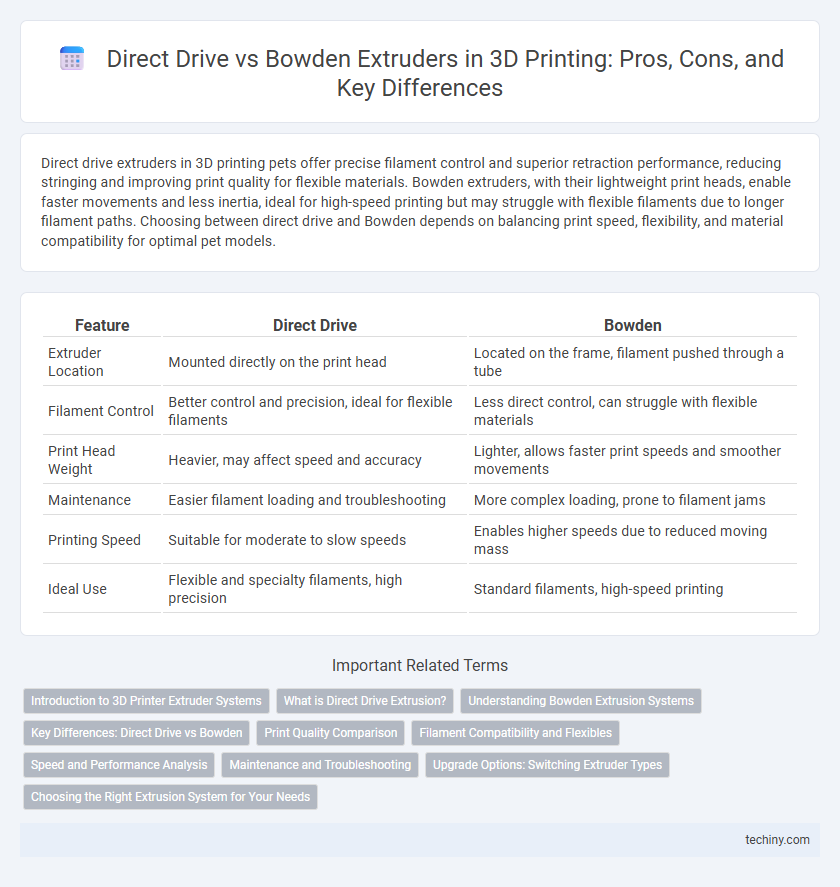Direct drive extruders in 3D printing pets offer precise filament control and superior retraction performance, reducing stringing and improving print quality for flexible materials. Bowden extruders, with their lightweight print heads, enable faster movements and less inertia, ideal for high-speed printing but may struggle with flexible filaments due to longer filament paths. Choosing between direct drive and Bowden depends on balancing print speed, flexibility, and material compatibility for optimal pet models.
Table of Comparison
| Feature | Direct Drive | Bowden |
|---|---|---|
| Extruder Location | Mounted directly on the print head | Located on the frame, filament pushed through a tube |
| Filament Control | Better control and precision, ideal for flexible filaments | Less direct control, can struggle with flexible materials |
| Print Head Weight | Heavier, may affect speed and accuracy | Lighter, allows faster print speeds and smoother movements |
| Maintenance | Easier filament loading and troubleshooting | More complex loading, prone to filament jams |
| Printing Speed | Suitable for moderate to slow speeds | Enables higher speeds due to reduced moving mass |
| Ideal Use | Flexible and specialty filaments, high precision | Standard filaments, high-speed printing |
Introduction to 3D Printer Extruder Systems
Direct drive extruders position the motor directly on the print head, providing precise filament control and better retraction performance for flexible materials. Bowden extruders place the motor remotely, using a long PTFE tube to feed filament to the hotend, resulting in a lighter print head and faster movement speeds. Selecting between direct drive and Bowden systems depends on factors such as print speed, filament type, and desired print quality.
What is Direct Drive Extrusion?
Direct drive extrusion is a 3D printing technology where the extruder motor is mounted directly on the print head, allowing precise control of filament feeding. This setup enhances extrusion accuracy and responsiveness, particularly with flexible filaments like TPU, due to reduced distance between the drive gear and hotend. Compared to Bowden systems, direct drive extruders minimize issues like filament retraction problems and stringing, improving overall print quality and reliability.
Understanding Bowden Extrusion Systems
Bowden extrusion systems use a remote-mounted extruder motor connected to the hotend by a PTFE tube, reducing the weight on the printhead and allowing faster, more precise movements. These systems are ideal for flexible filaments, as the reduced moving mass minimizes stringing and oozing, but they may introduce slight filament compression, affecting retraction performance compared to direct drive setups. Understanding the trade-offs between filament control and printhead agility is crucial when selecting a Bowden system for specific 3D printing applications.
Key Differences: Direct Drive vs Bowden
Direct Drive extruders position the motor directly on the print head, enabling precise filament control and improved performance with flexible materials, while Bowden systems place the motor on the frame, reducing moving mass for faster print speeds but potentially compromising retraction accuracy. Key differences include retraction distance, with Direct Drive requiring shorter retraction due to proximity of the extruder to the hotend, and Bowden needing longer retractions to counteract filament elasticity in the lengthy PTFE tube. Direct Drive setups offer superior control over flexible and soft filaments, whereas Bowden setups excel in high-speed printing and lighter print head designs.
Print Quality Comparison
Direct Drive extruders provide superior print quality by reducing filament retraction issues and enabling precise extrusion control, which is essential for flexible and detailed materials. Bowden setups often cause slight delays in filament response due to the longer tube, leading to minor stringing or blobbing, impacting overall print fidelity. For users prioritizing fine detail and surface finish, Direct Drive systems typically deliver more consistent and accurate results.
Filament Compatibility and Flexibles
Direct drive extruders offer superior filament compatibility, especially with flexible materials like TPU and TPE, due to their short filament path and precise control. Bowden setups can struggle with soft filaments because of the long, rigid tube, leading to filament buckling and inconsistent extrusion. Choosing direct drive enhances print quality and reliability when working with flexible filaments in 3D printing.
Speed and Performance Analysis
Direct Drive extruders offer superior retraction control and faster response times, making them ideal for detailed prints and flexible filaments. Bowden setups reduce the moving mass on the print head, enabling higher print speeds but can suffer from decreased extrusion precision and potential stringing issues. The choice between Direct Drive and Bowden significantly impacts print speed and performance, with Direct Drive excelling in accuracy and Bowden favoring faster, less detailed prints.
Maintenance and Troubleshooting
Direct drive extruders offer easier maintenance with simpler filament loading and fewer moving parts exposed, reducing troubleshooting complexity. Bowden setups require more frequent adjustments due to longer filament pathways, increasing the likelihood of clogs and tension issues affecting print quality. Understanding the mechanical differences helps optimize troubleshooting processes and minimize downtime in 3D printing operations.
Upgrade Options: Switching Extruder Types
Switching between Direct Drive and Bowden extruders offers significant upgrade opportunities to enhance print quality and filament compatibility. Direct Drive extruders provide better control for flexible filaments, while Bowden setups enable faster retractions and reduced weight on the print head. Upgrading requires careful consideration of printer compatibility, firmware adjustments, and potential hardware modifications to ensure optimal performance.
Choosing the Right Extrusion System for Your Needs
Selecting the right extrusion system depends on print quality, material type, and printer setup. Direct drive extruders offer better control for flexible filaments and complex detailed prints due to their proximity to the hotend. Bowden systems reduce moving mass, enabling faster print speeds and smoother movements but may struggle with flexible materials and require more fine-tuning.
Direct Drive vs Bowden Infographic

 techiny.com
techiny.com